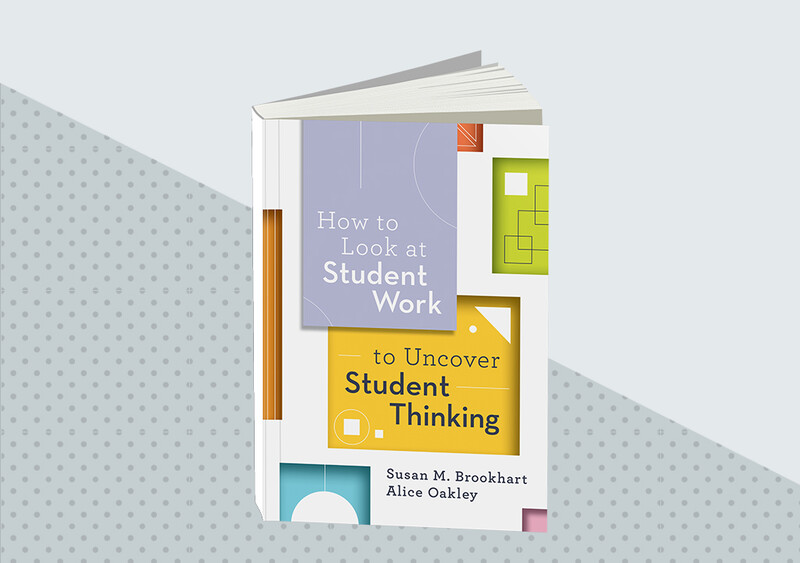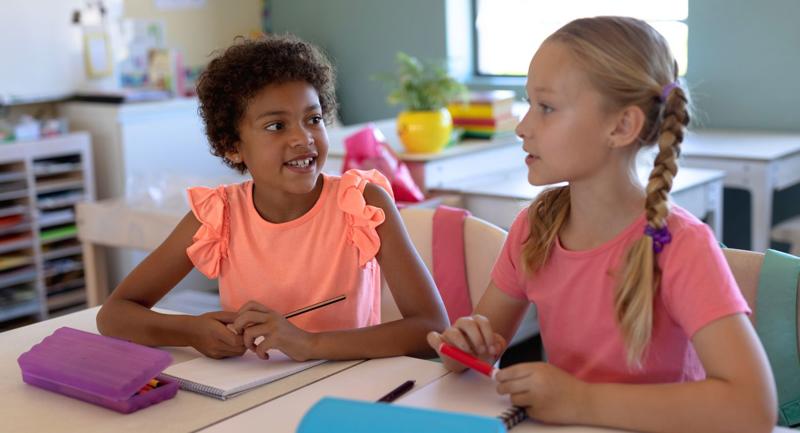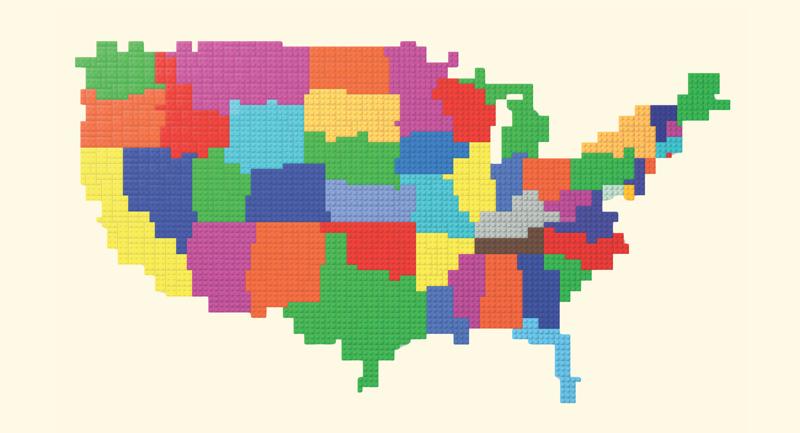Looking at student work can be a powerful source of feedback. Because student work provides evidence of what students have learned (or not) and what students are thinking, it gives teachers feedback about their teaching—and how to improve it. We might say student work is a source of feedback that leads to better feedback. When teachers share with students what they see from a close analysis of student work—and deliver their thoughts to each learner in a way that goes beyond noting what’s correct and incorrect—they give students insights that lead to real learning.
Unfortunately, teachers often evaluate student work according to whether it’s right or wrong, or according to how many points are scored. This does provide learners a kind of feedback about level of achievement, but it is evaluative (that is, it makes a judgment like “satisfactory” but doesn’t explain what is satisfactory about the work) and backward-looking (when a teacher says, “here’s your score,” a student generally thinks, how did I do?). But when teachers look at student work to figure out what and how students are thinking, they can give comments that are more descriptive (“Here’s what you seem to be thinking and understanding now”) and forward-looking (when a teacher says, “here’s something else you might think about in this work” a learner generally thinks, maybe I’ll try this next).
An Orientation Toward Understanding
Looking at student work for evidence of student thinking more than correctness is a powerful method for changing the school culture to one in which educators and students alike focus on student understanding. When teachers focus their feedback on what students know or think, students become oriented toward learning rather than being right or completing the work. Teachers become oriented toward teaching for understanding.
To make this shift from correcting work to understanding student thinking, teachers must take a formative approach, considering where students are on the journey toward a learning target—not just whether they’ve hit the target. This formative approach changes the cultural dynamics of the classroom from one in which students earn grades by scoring points to one in which students demonstrate understanding by showing their thinking. It also changes a teacher’s focus from imparting information to helping students process and assimilate that information. These changes create a climate in classrooms of learning rather than earning—and that climate often involves teachers learning about student thinking together by reflecting on samples of their students’ work in professional learning groups.
This shift toward looking closely at student work to understand students’ thinking is a welcome, relatively recent development. Until around the mid-1990’s (when school reform advocates discovered how much attending to students’ experiences and thought processes as evidenced in their work benefits teaching and learning), teachers typically looked at their students’ work individually, not with colleagues. Student work didn’t have much of a presence in professional development (Little et al., 2003). And typically, teachers just checked whether the work was correct, often using the phrase “grading papers” whether or not they were recording grades.
More recently, looking at student work has become the foundation for several professional development projects in formative assessment, such as the Assessment Work Sample Method (AWSM) (Beesley et al., 2018) and Mathematics Learning Communities (MLC) (Cleaves & Mayrand, 2011). These projects and research have affected teachers and their teaching, especially on the quality of the feedback teachers give students. For example, in the AWSM project, math teachers’ feedback moved from more evaluative to more descriptive—from giving nonspecific judgment or praise to providing descriptions of how students’ work met success criteria and suggestions for improvement. Teachers also began encouraging students to reflect, identify where they need help, and revise their work.
Putting It Out There: Worth the Risk
Research points to at least four beneficial outcomes when teachers look at student work together, using it as evidence to infer how students are understanding what they’re meant to be learning:
Better understanding of what students are thinking about the concepts and skills they are learning.
More effective feedback that is more descriptive and more likely to involve students.
More targeted next instructional moves to address students’ current thinking.
Satisfying and productive professional development.
In our work as consultants, guiding groups of teachers looking at student work, we have seen these same outcomes (Brookhart & Oakley, 2021). For example, in one professional learning community that one of us, Alice, facilitated at an elementary school, Ms. Trent, a 3rd grade teacher, risked sharing some student work that didn’t go quite as planned. By reflecting publicly on that work and her instructional moves behind it, she gained a better understanding of what her students were thinking and what they were missing about key concepts.
Ms. Trent was teaching about plants as part of a unit on ecosystems, with learning goals aligned to her state’s standards. One goal was for students to understand how plants survive in their environments. As one learning activity, students planted the same kinds of seed in two different environments and then noted what happened over several weeks, using a Plant Observation Log form Ms. Trent designed. Students dutifully and busily filled in the forms, and she thought all was well.
Looking at student work for evidence of student thinking more than correctness is a powerful method for changing the school culture to one in which educators and students alike focus on student understanding.
But later, looking over the logs along with other members of the PLC, she realized many of the students had just listed which seeds had germinated on each observation day, something she hadn’t noticed when she was walking around observing her students. The students’ work contained no detailed notes about changes in the plants, little relevant science vocabulary, and no connections with what they were learning in the ecosystem unit—three things Ms. Trent was interested in looking for. The assignment hadn’t produced the evidence of learning she’d hoped for—and she didn’t know if the students hadn’t learned those things or simply hadn’t included them in their observations.
Discussing students’ logs with colleagues provided feedback to Ms. Trent—helping her realize her students had needed more feedback on the quality and depth of what they wrote in their logs during their observation work. By sharing these results, this teacher learned some things about feedback that will likely “stick” and change her practice more deeply than most other professional learning she could have undertaken.
Looking Together Is Powerful
The process just described uses inductive reasoning: teachers look at student work, interpret it in terms of student thinking, ask questions, and reflect. This sets it apart from professional learning that begins with a didactic presentation, then has teachers apply the principles taught to their practice—reflecting deductive reasoning. With PLC-type teacher learning, there’s a way into the learning conversation for everyone (everyone has samples of student work). And because every teacher’s student work is different, differentiation is built into this learning. Thinking out loud with colleagues models for everyone the process of analyzing student thinking.
While looking at student work together, teachers sometimes decide to seek outside sources to learn more about feedback or other aspects of instruction. But the impetus comes from the student work—and teachers’ curiosity about that work.
One thing that becomes evident as teachers look together at student work is that some tasks are better at eliciting student thinking than others. Sometimes they realize that their students didn’t think much because the task they were posed didn’t ask them to. For example, if students are assigned to do a science “experiment” task with a cookbook-style list of directions; everyone’s experiment will turn out the same. Work on the task will likely yield no evidence of scientific reasoning. Observations like these can lead teachers to see how small changes in their learning activities, assignments, and assessments can lead to big changes in students’ thinking.
Feedback that Strengthens Teachers’ Practice
Professional learning in PLCs based on looking at student work is an exciting and dynamic process. The focus on a teacher’s own students’ work makes the discussion immediately relevant to her actual practices. Sometimes group problem solving occurs. Other times, teachers have an individual “aha!” moment inspired by the group’s reflection.
An example of group problem solving occurred in a PLC session we witnessed where a 6th grade teacher shared a set of quick-writes she had used as exit tickets after a lesson on the migration of the first peoples into North and South America. The lesson was part of a larger unit about the movement of people, goods, and ideas in civilizations. The quick-write prompt read “How did North and South America become populated by the first Americans?” Most students simply copied or paraphrased a sentence or two from their textbook.
The student work samples were only a sentence or two each, but they sparked a lively conversation. It turned out that others in the group had also run into the problem of students giving minimal, literal answers copied or paraphrased from the textbook. The group brainstormed possible solutions to this problem that they all could try. They could:
Change the phrasing of the prompts to make it clearer that more was required than a textbook sentence (e.g., Describe at least one thing about the migration routes of the first Americans (see the map on p. x of your textbook) that makes the migration seem like an amazing feat to us today).
Model good responses and give students feedback on the quality of their responses, so students could understand how to provide more thoughtful answers.
An example of an “aha!” moment we observed for one educator related to a 3rd grade geometry lesson. Ms. Watson had been working with her students to categorize shapes based on their attributes. She wanted them to learn how to recognize and ultimately draw examples of quadrilaterals, so she assigned them to compare and contrast a rhombus and a rectangle, then sort six shapes (not all quadrilaterals) into two groups according to properties they shared. Ms. Watson brought several student examples, which she had already reviewed, to a professional development conversation.
One of her breakthrough realizations came as the group examined this work together. She realized her students who typically perform below level were providing excellent compare and contrast explanations. This surprised her. Looking closely, she realized these students were using vocabulary from the unit and providing details to support their mathematical thinking. For example, one typically low-performing student wrote: “The rhombus and the rectangle are alike because they are both quadrilaterals. The rhombus and the rectangle are different because the rhombus has four equal sides but the rectangle doesn’t.” Then, in the sorting task this student made two groups, which she labeled “Quadrilaterals” and “Not quadrilaterals.”
On the other hand, her students who typically scored well on more formal assessments had correctly identified quadrilaterals, but only gave surface-level explanations of why these were quadrilaterals. One typically high-performing student wrote: “They both have 4 sides. They both are polygons. The diamond all the sides are the same.” In the sorting task, he simply wrote the number of sides inside each figure, implying but not actually sorting. Their explanations lacked the depth she was looking for in their mathematical thinking—perhaps simply because they didn’t take the time to explain what they may have thought was obvious.
During discussion with her PLC, Ms. Watson realized she needed to give specific feedback to both groups of students rather than just putting a grade on the assignments. She practiced naming and noticing what the struggling students did well in hopes that they’d do so in future work. And she gave precise feedback to the students who weren’t able (or weren’t taking time to) clearly communicate their math thinking and lacked depth in their responses. Differentiating her feedback based on what she saw in student thinking, even when it didn’t “fit” expectations based on formal test performance, was an important professional learning experience for this teacher.
In an effective feedback episode drawing on student work, not only does the teacher learn something, the student involved learns something important about their work, and next steps. Many students experience feedback that is mostly grades, scores, or explanations of where points were gained or lost. Students can use this information, at least some of the time, but there’s a better way. Effective feedback to students:
Is based on criteria that have been shared with students ahead of time.
Notices and names at least one thing the student did well and makes at least one suggestion for improvement.
Includes an opportunity for the learner to use the information to improve this or future work.
For example, Mr. Wright’s algebra class was beginning to learn to solve pairs of linear equations. Students considered the following problem:
Tara sent 14 friends either a letter or a postcard. She spent $3.84 on postage. If it costs $0.20 to mail a postcard and $0.33 to mail a letter, how many letters did Tara send? Show what you did to get your answer.
There are several ways to solve this problem, including guess-and-check, making a table, and using linear equations. One enterprising student, Darcy, used guess-and-check and arrived at the correct answer (8 letters). She began by guessing 4 letters, then 5, 6, and 7, respectively. When she got to 8 letters, she found that the postage for 8 letters and 6 postcards amounted to $3.84.
Feedback to Darcy might be simply “correct,” or assigning full points. That would let her know she got the right answer but wouldn’t give her any information about what next steps she needed to take to keep learning. Because she “showed her work,” Darcy’s solution contains more information than just the right answer. Full use of that information should focus on what she has learned and what she can learn next.
Mr. Wright might notice that the evidence showed Darcy understands what it is to reason systematically; she started at a reasonable guess of 4 and worked incrementally until she reached the right answer. Feedback on her thinking could start by naming and noticing this characteristic of her reasoning. Then, Mr. Wright might encourage Darcy to stretch her thinking by asking her if she could think of a way to model the problem, or even part of it, in a linear equation (for example, #Postcards + #Letters = 14).
This would be a realistic “stretch” because the class had studied simple linear equations in a prior unit, before tackling systems of equations, as an efficient strategy to this problem would involve. If Darcy could successfully model even one of the two equations needed to solve this problem using systems of equations, it could be the next step in her journey toward being able to use linear equations to solve problems.
Shifting the Classroom Culture
When teachers and students look at student work for evidence of thinking, feedback becomes personalized for students and professional development becomes personalized for teachers. Instead of being overwhelmed deciding what to do next to further a student’s (or students’) learning, a teacher will have a clear direction of how to guide the student, based on evidence of that learner’s thinking. She or he can select instructional moves accordingly. This is empowering—and an entirely different mindset from assign and assess, grade, and file away.
Students benefit by having their thinking “heard” and made the focus of classroom learning. The talk between student and teacher becomes more authentic, shifting from (in many cases) what students did wrong to what they are learning and sharing, and how they are growing. Students see themselves as part of the learning process and are empowered by their ability to realize how their own thinking impacts the outcomes.
By extension, the school culture becomes focused on learning, too. A cycle is created: student work provides a window into a student’s thinking, which the teacher uses to determine and carry out next instructional steps, ideally fostering more growth in thinking. A deep awareness develops of the students—the learners—we are serving.
Uncovering Student Thinking
In their latest book, Susan M. Brookhart and Alice Oakley unpack how to more effectively analyze student work.










